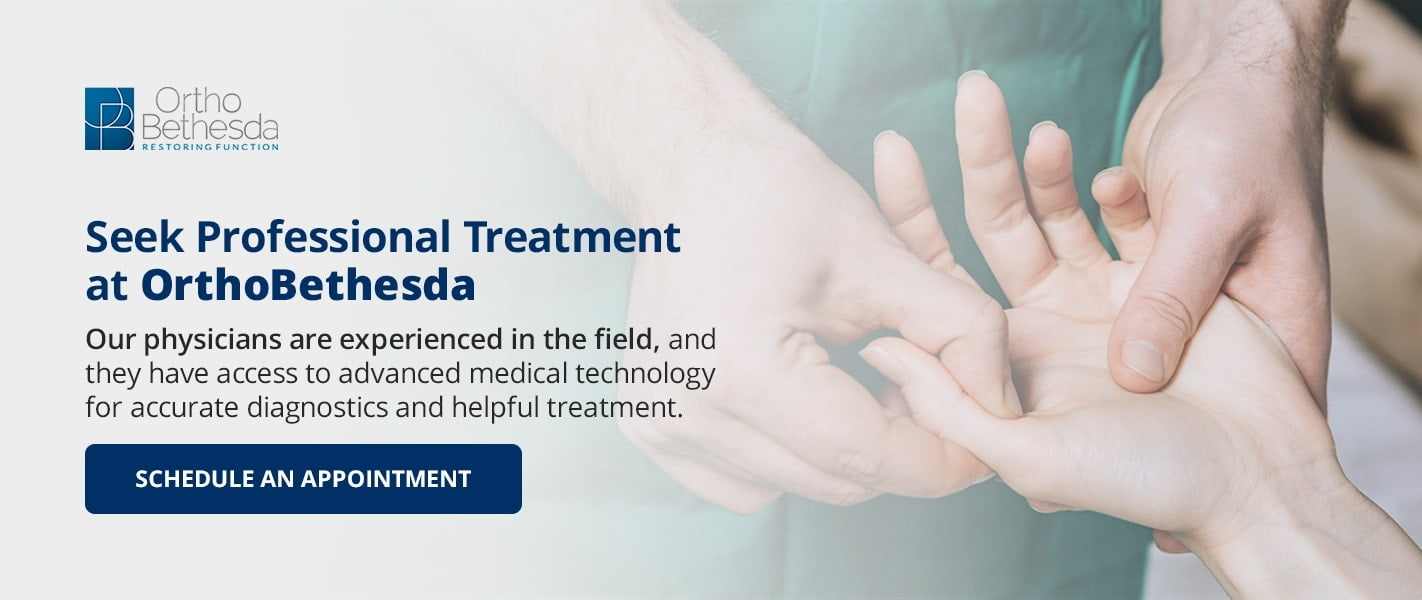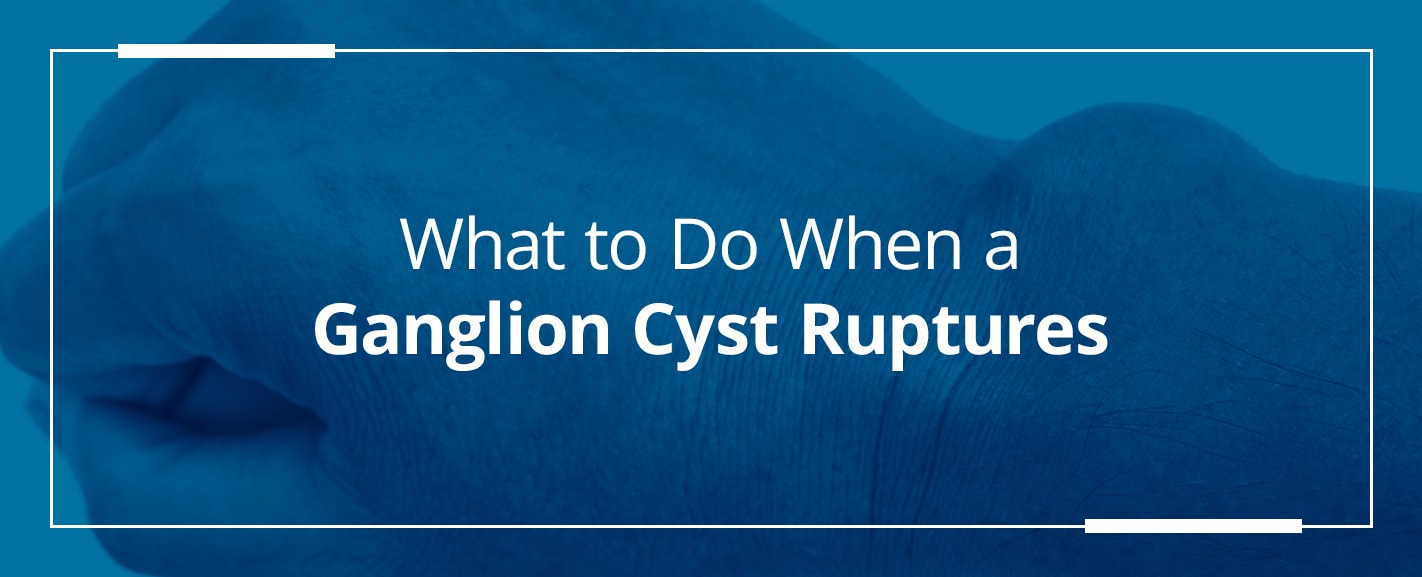
A ganglion cyst is a soft lump connected to a joint on your body. These cysts are noncancerous, and though they can be uncomfortable, you can live with them without treatment if you choose. However, a ganglion cyst may burst, especially during intense physical activity. If a ganglion cyst suddenly ruptures, you may feel surprised, concerned and confused about what to do next.
What happens if a ganglion cyst ruptures, and how can you take care of yourself when it does? We’re here to help give you some answers. This guide will detail what ganglion cysts are, how medical professionals treat them and what to do if a ganglion cyst bursts. We’ll also answer some frequently asked questions about ganglion cysts and ruptures.
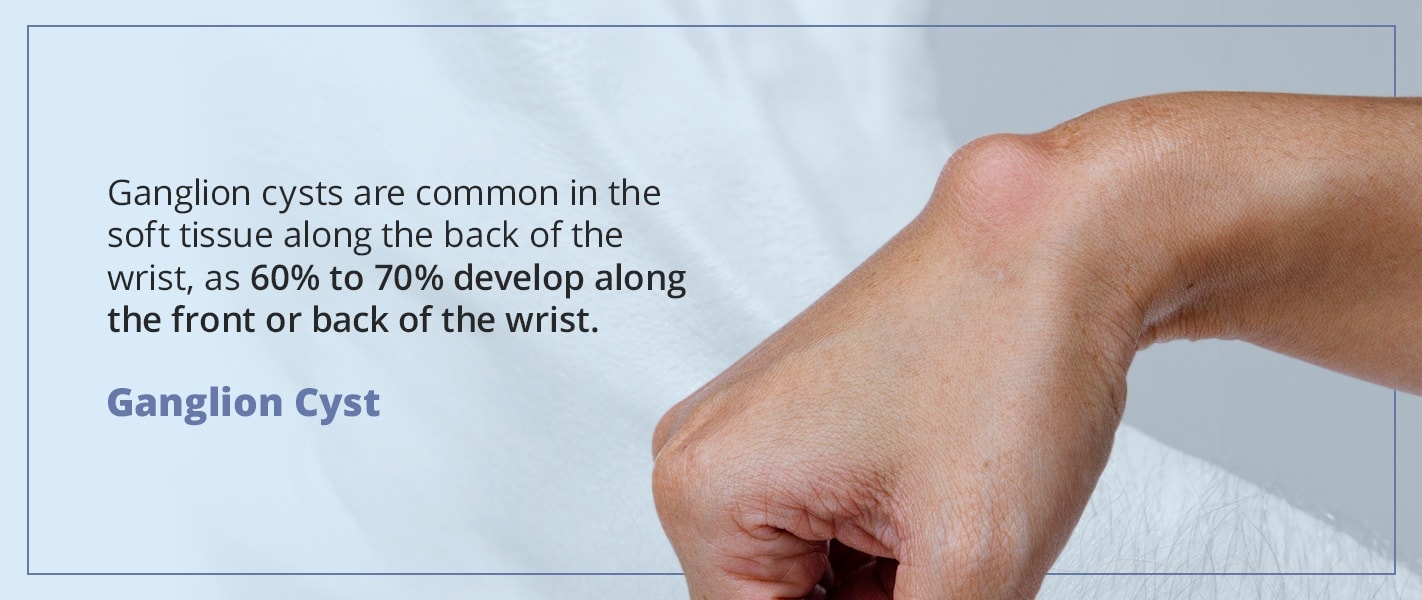
What Is a Ganglion Cyst?
A ganglion cyst is a benign sac of tissue that often develops on the hand or wrist, usually attached to a tendon or joint. Ganglion cysts are common in the soft tissue along the back of the wrist, as 60% to 70% develop along the front or back of the wrist. The cysts contain a viscous fluid that is similar to the lubricating synovial fluid that naturally cushions the joints and tendon sheaths. The cyst may feel like an inflated, slightly mobile water balloon under the surface of your skin.
Ganglion cysts are round or oval, and they vary in size. A small cyst might be no bigger than a pea, or even so tiny that you can’t feel it in your body. Larger cysts can grow to be larger than grapes — about an inch or so in diameter — and a few may even become plum-sized. On the wrist, ganglion cysts have different names depending on their locations:
- Dorsal ganglion cyst: A ganglion cyst that develops on the back of the wrist is a dorsal wrist ganglion cyst.
- Volar ganglion cyst: A ganglion cyst on the underside of the wrist is a volar wrist ganglion cyst.
Less commonly, a ganglion cyst may form on a foot or ankle or near other joints in the body.
The cysts may increase and decrease in size, becoming larger if you engage in repetitive motions with the affected joint and smaller with less joint use. A person who does a series of push-ups every day, putting repetitive strain on the wrists, may develop a ganglion cyst that grows larger as the daily repetitions continue. Unlike cancerous lumps, these cysts never spread to other areas of the body.
Ganglion cysts are not always painful, but they can be if they sit close to a nerve in the wrist or hand. A cyst located next to a nerve may cause discomfort, numbness, tingling, diminished range of motion or muscle weakness — even if it is so small it doesn’t form a visible lump. If the cyst sits close to the joint, it can also interfere with the wrist’s movement and function.
Ganglion cysts may go away on their own as your body absorbs the fluid over time. Up to 58% of cysts resolve themselves in this way. If your cyst persists, is painful or makes it hard to accomplish daily tasks or participate in hobbies you enjoy, you may decide to seek medical treatment.
Why Do Ganglion Cysts Form?
No one is certain why ganglion cysts form. We know they grow out of the linings of joints and tendons and seem to occur when the tissue around a tendon or joint erupts out of place. They often develop when some of the lubricating fluid that cushions the joints leaks out into the area of tissue just under the skin. We also know they frequently develop in joints with arthritis or as a result of repetitive stress activities.
Scientists are not sure about the exact mechanisms of cyst formation or what people could do to prevent ganglion cysts from developing. One theory is that the body responds to injury or overuse by forming the cyst as a sort of internal blister. Another is that small tears in the joint capsule or tendon membrane allow synovial fluid to seep out and form a cyst.
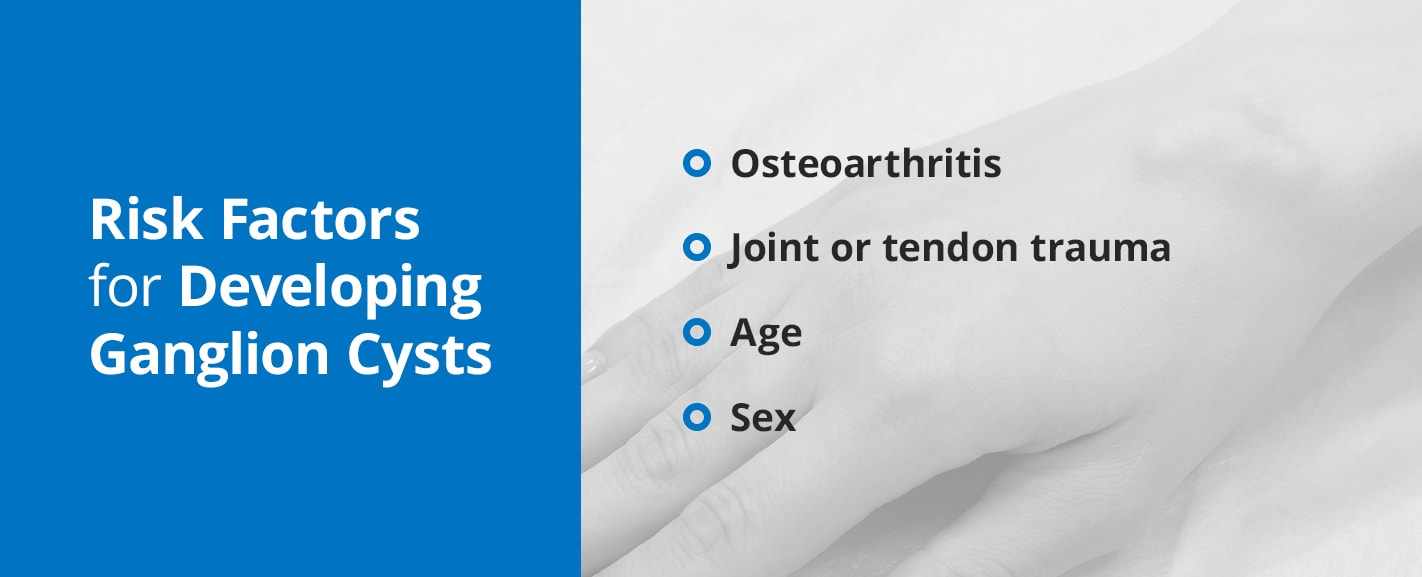
What Are Some Risk Factors for Developing Ganglion Cysts?
Doctors recognize a few risk factors that can mean a person has a higher likelihood of developing a ganglion cyst:
- Osteoarthritis: A person who already has osteoarthritis is at higher risk of developing ganglion cysts in the joints.
- Joint or tendon trauma: Ganglion cysts are also common in people who have experienced an injury to a tendon or joint.
- Age: Ganglion cysts are more likely to occur in people between 15 years and 40 years of age, though they occur in young children and older people as well.
- Sex: Ganglion cysts develop more commonly in women than in men.
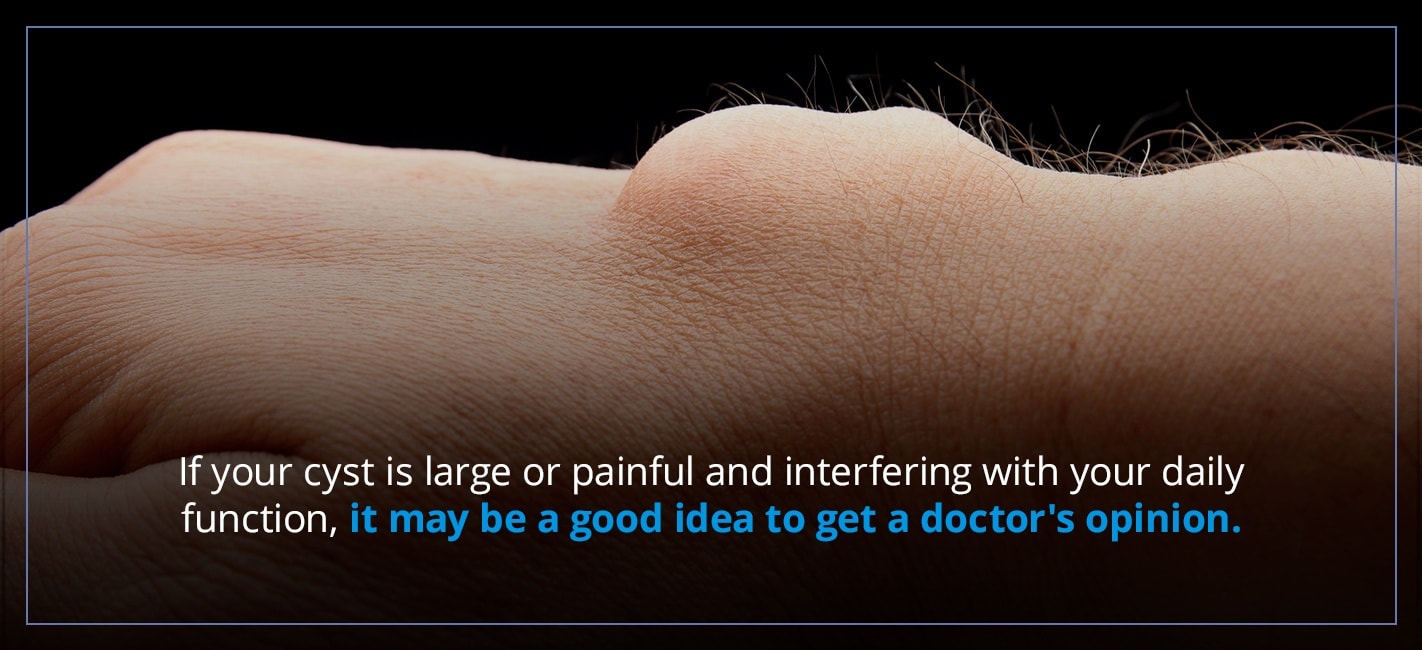
Seeing a Doctor for a Ganglion Cyst
Should you see a doctor when you develop a ganglion cyst? It depends. Because these cysts often go away on their own, many people choose a wait-and-see approach, especially if the cyst is small and not causing discomfort. If your cyst is large or painful and interfering with your daily function, it may be a good idea to get a doctor’s opinion.
In an appointment for a ganglion cyst, the doctor may first perform a few simple tests, such as shining a light on the cyst to determine whether it is solid tissue or a liquid-filled sac. The physician may also touch the cyst gently to assess the level of discomfort it causes. After these tests, you might have an imaging test like an X-ray, an ultrasound or a magnetic resonance imaging (MRI) scan. These procedures can help rule out conditions such as arthritis and cancerous tumors.
The doctor might also use aspiration to confirm the diagnosis. Aspiration uses a syringe and needle to extract some of the fluid from the cyst. If the lump is a ganglion cyst, it will contain clear, almost transparent fluid.
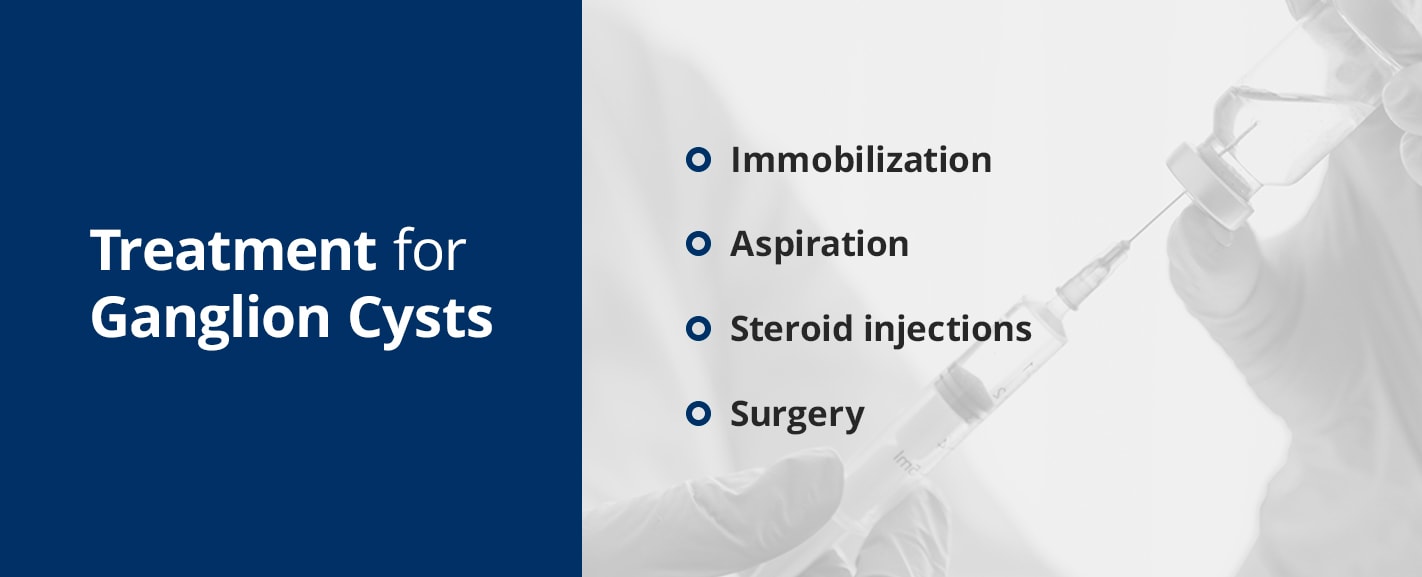
Treatment for Ganglion Cysts
If you elect to have medical treatment for your ganglion cyst, your doctor will most likely recommend one of the following options:
- Immobilization: Your doctor may suggest that you immobilize the affected joint with a splint or brace. If the joint cannot move, the ganglion cyst will often shrink, releasing the pressure on your nerves and relieving the pain.
- Aspiration: Minor aspiration is useful for diagnostic purposes, and more aggressive aspiration can remove most of the fluid from the cyst. This treatment should provide near-immediate pain relief, though it is possible in some cases that the drained cyst will slowly fill back up with fluid because the structure of the cyst is still there. Aspiration merely drains out the fluid, much like letting the water out of a water balloon that you could fill again.
- Steroid injections: Steroid injections are sometimes useful in treating ganglion cysts because of their effectiveness as pain relievers. Your health care provider may give you a steroid injection to make your everyday activities less painful. Physicians also sometimes use steroid injections with aspiration, injecting the steroid into the deflated cyst to help shrink the lesion and reduce the risk of recurrence.
- Surgery: During surgery, the physician removes the cyst and stalk of tissue connecting it to the nearby joint or tendon sheath. This type of surgery is known as ganglion excision, or a ganglionectomy. The surgeon uses general anesthesia, so you’ll be unconscious and won’t feel or remember what happens, and the surgery is an outpatient procedure, so there’s no hospital stay involved. A surgical approach is often effective, and it carries less risk of cyst recurrence. Because it is the most invasive option, many doctors prefer to try more conservative treatment methods first.
Treatment is likely to depend on the kind of ganglion cyst present. With a volar cyst, physicians sometimes hesitate to perform aspiration because of the heightened risk that the needle could damage the delicate tendons and blood vessels in the inner wrist, particularly the radial artery. Though surgical treatment is possible on a volar wrist ganglion cyst, the procedure is more complicated and the site will likely take longer to heal.
Recovery From Ganglion Cyst Removal
After having a cyst removed, you can expect to experience or take part in the following for recovery:
- Splinting: After aspiration or surgery to remove a ganglion cyst, you’ll likely have a splint on your hand for a week or more. The splint will protect the excision site and prevent you from using the affected joint too much until it has healed. You’ll want to leave the splint on only as long as your doctor recommends — wearing it longer can stiffen the joint and prolong your recovery time.
- A few weeks of recovery: Depending on the cyst’s location, you may find that a full recovery takes a couple of weeks to a couple of months. Participating in your doctor’s recommended exercises and taking care not to overexert yourself can help speed the recovery.
- Physical therapy: Physical therapy will not remove an existing ganglion cyst. However, physical therapy exercises are often useful in recovery after cyst removal. These exercises can help you restore strength and a full range of motion to your wrist and hand. Strengthening your muscles can also prevent future joint injuries, thus reducing the chances of future cyst formations.
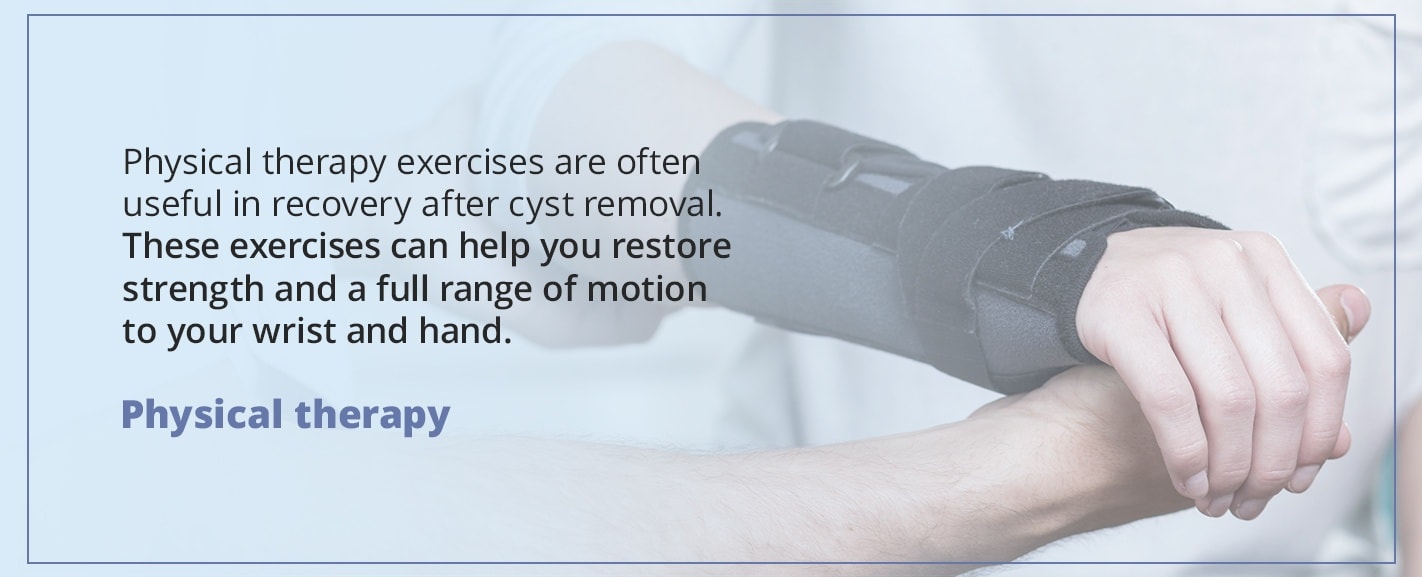
What questions should you ask your health care provider before committing to medical treatment for a ganglion cyst? Here are a few ideas to help you get started:
- How will you determine the right treatment for my ganglion cyst?
- What risks are associated with the treatment I have planned?
- How much pain will I experience, and how should I manage it?
- How long will the recovery process take?
- How should I take care of myself during recovery?
- What activities should I avoid during recovery?
- When can I resume normal activities?
- What therapy exercises or stretches do you recommend?
- What potential issues should I be alert for, and what should I do if they occur?
- What is the likelihood the cyst will recur after treatment?
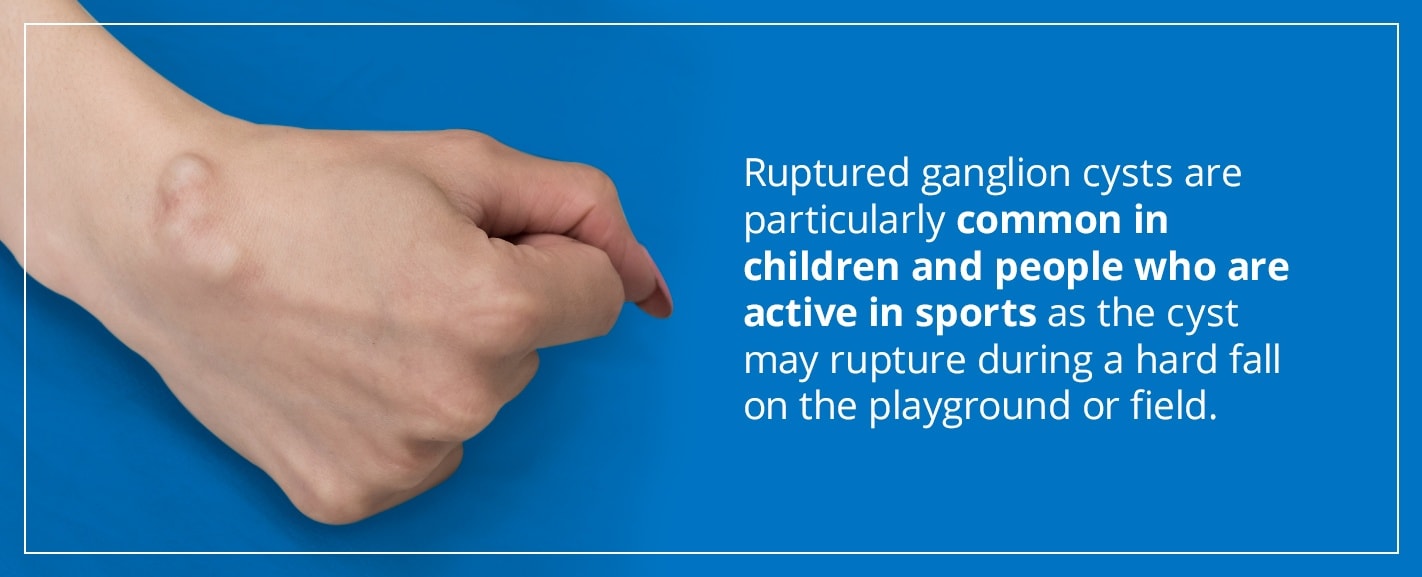
What Is a Ganglion Cyst Rupture?
Sometimes, if you don’t seek medical treatment, a ganglion cyst may rupture on its own. Ruptured ganglion cysts are particularly common in children and people who are active in sports as the cyst may rupture during a hard fall on the playground or field. Many ganglion cyst ruptures occur because of hard impacts, either because the person falls or runs into something or because the person deliberately makes hard contact with the cyst in an attempt to remove it.
What happens when a ganglion cyst ruptures? Under the pressure of the impact, the cyst bursts internally and the fluid spreads out beneath the skin. Eventually, the bloodstream absorbs it. The affected area will likely be red, sore and swollen for a few days. You might also feel a sensation similar to the feeling of water running along the location where the cyst ruptures.
How Do You Treat a Ruptured Ganglion Cyst?
A ganglion cyst rupture isn’t usually hazardous to your health, but it can be painful for several days as the fluid from the cyst leaks into the surrounding muscle tissue. Treating a ganglion cyst generally involves managing your pain until the area of the rupture feels better.
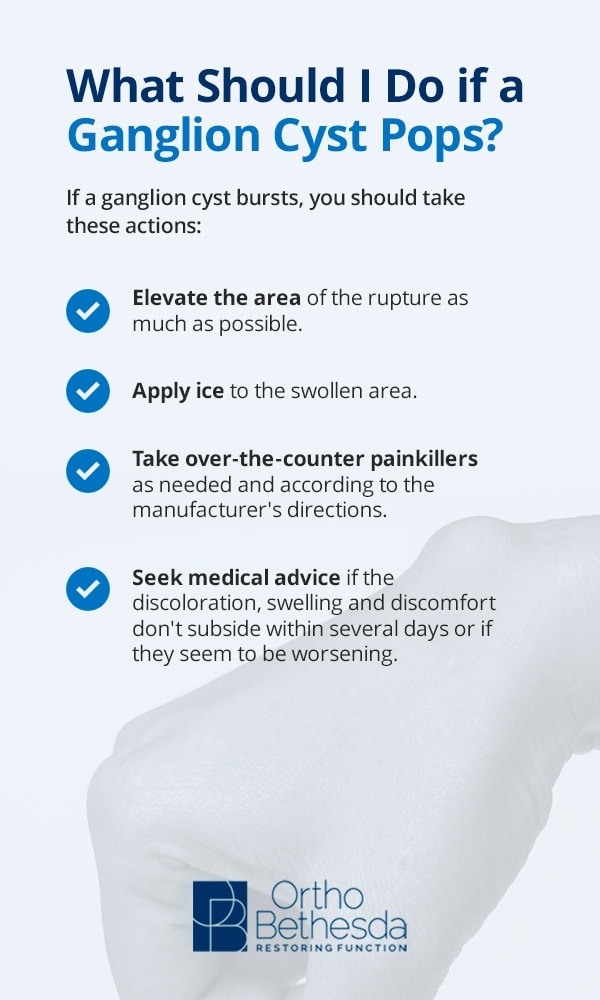
What Should I Do if a Ganglion Cyst Pops?
Let’s discuss the steps of what to do when a ganglion cyst ruptures. If a ganglion cyst bursts, you should take these actions:
- Elevate the area of the rupture as much as possible.
- Apply ice to the swollen area.
- Take over-the-counter painkillers as needed and according to the manufacturer’s directions.
- Seek medical advice if the discoloration, swelling and discomfort don’t subside within several days or if they seem to be worsening.
Frequently Asked Questions About Ganglion Cysts
Below are a few frequently asked questions about ganglion cysts and ganglion cyst ruptures:
1. Can You Pop a Ganglion Cyst?
It is physically possible to pop a ganglion cyst. Some people feel tempted to hit their ganglion cysts with heavy objects to rupture them. Ganglion cysts are sometimes colloquially known as “Bible cysts” because a common treatment method in the past was to hit them with a large, heavy book like a Bible or dictionary to cause them to rupture.
For a variety of reasons, we strongly recommend avoiding this option. Smashing your ganglion cyst with an object like a heavy book can leave you vulnerable to infection if you damage the external layer of your skin. Bacteria can enter through this wound, spread via the cyst cavity to your joint and cause a joint infection that becomes incredibly difficult to treat. Hitting your cyst can also severely damage the delicate tissues and bones of your hand and wrist.
You don’t want to end up breaking your hand, misaligning your joints or giving yourself a serious infection when safer and more effective options are available. Popping a ganglion cyst yourself leaves the cyst’s walls intact, so it may fill back up with fluid and leave you with another visible cyst on your body.
2. Does a Ganglion Cyst Hurt When It Pops?
A ganglion cyst can be painful when it ruptures. Apart from potentially being located near a nerve in your body, the cyst also discharges a substantial amount of fluid that can inflame the surrounding tissues, making them sensitive and tender.
To relieve the discomfort, you can try taking over-the-counter medications like acetaminophen or ibuprofen. Be sure to follow the label instructions carefully, and consult with your health care provider before taking any of these medications over the long term.
3. Can You Massage a Ganglion Cyst Away?
Generally, massage will not remove a ganglion cyst. Massaging a ganglion cyst can have some benefits, though — it may cause some of the fluid to seep out of the sac, making the cyst grow smaller. Though massage can provide a small amount of relief, you’ll likely want to seek professional medical treatment if the cyst does not disappear on its own.
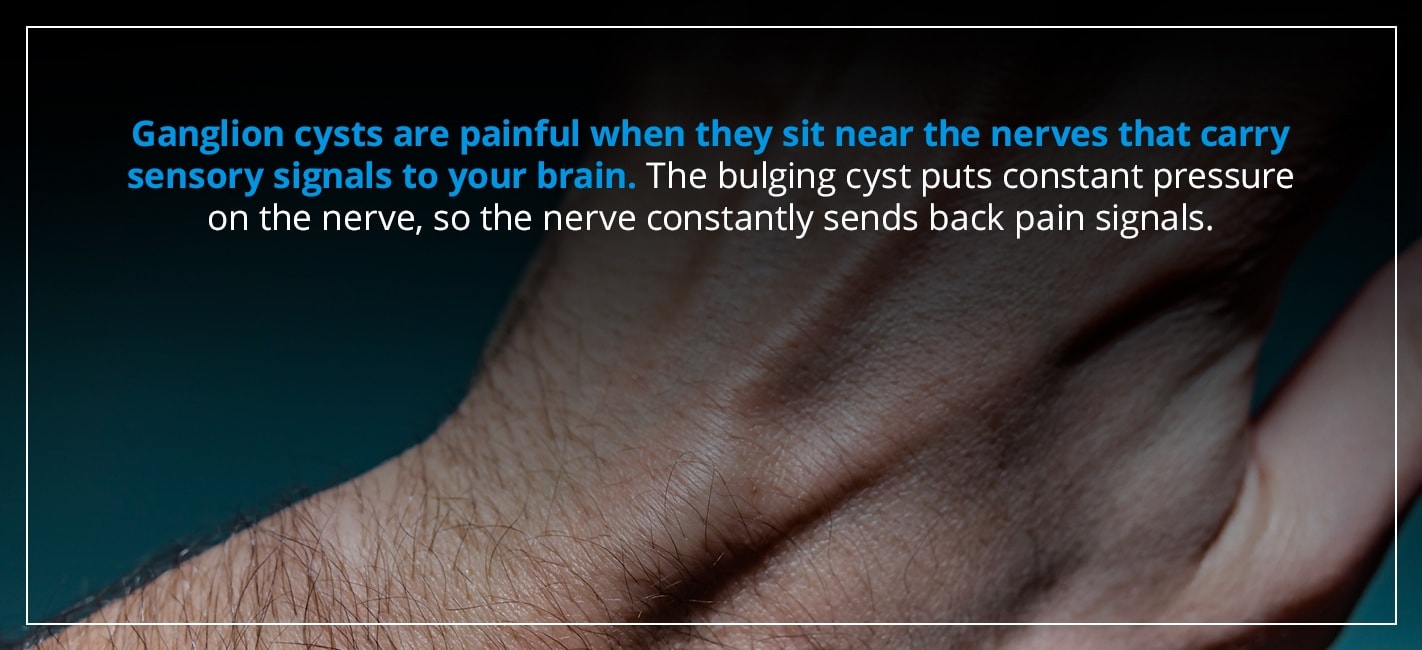
4. Why Is My Ganglion Cyst So Painful?
Ganglion cysts are painful when they sit near the nerves that carry sensory signals to your brain. The bulging cyst puts constant pressure on the nerve, so the nerve constantly sends back pain signals. If your ganglion cyst is incredibly painful, it is likely very close to one of the nerves that run through the affected location.
5. Will Ice Help a Ganglion Cyst?
Ice is unlikely to shrink a ganglion cyst, but it can provide temporary pain relief. Try applying an ice pack — or an improvised pack like a bag of frozen vegetables — to the affected area for 20 minutes or so every few hours. Be sure to wrap the ice pack in a towel or other cloth so you don’t damage your skin. You can also use a warm compress to reduce pain. The warmth may also benefit you by increasing blood flow and promoting some fluid drainage.
If your ganglion cyst has already burst, ice can also help relieve pain at the rupture site.
6. How Long Do Ganglion Cysts Last?
The amount of time ganglion cysts are present can vary widely. It’s unlikely for a ganglion cyst to disappear overnight, but some cysts appear on your body and then disappear after a few weeks or months. Some may linger for over a year before eventually disappearing. Others may show no signs of shrinking on their own, and in that case, you may wish to seek a doctor’s advice.
7. How Do I Get Rid of a Ganglion Cyst Fast?
The best way to remove a ganglion cyst without waiting for it to go away on its own is to seek professional medical treatment. Because home remedies can hurt more than they help, it is best to talk to a doctor about ways to remove the cyst. An experienced professional can give you the best advice about removing your cyst safely and effectively.
Seek Professional Treatment at OrthoBethesda
To get caring, expert help with treating a ganglion cyst before it bursts, contact OrthoBethesda. You can come to us for a range of orthopedic services, whether for hand and wrist treatments or for help with conditions of the feet and ankles, elbows, hips, knees, shoulders or spine. We have extensive experience in treating ganglion cysts using immobilization, joint soft tissue injection and aspiration, and surgical options. We can also help rehabilitate your body after surgery with physical therapy.
Our physicians are experienced in the field, and they have access to advanced medical technology for accurate diagnostics and helpful treatment. Most importantly, our physicians and therapists are professional and compassionate in their interactions. Our team strives to figure out the best way to support you as you work toward improved health and a more comfortable quality of life.
Contact us today to book an appointment or learn more about our services.

